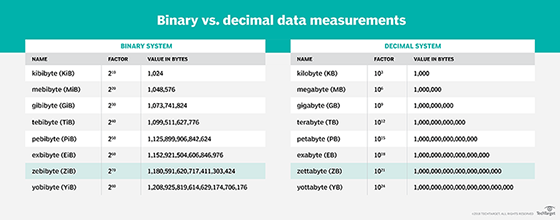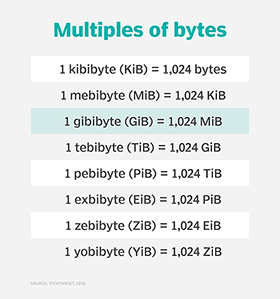yobibyte (YiB)
What is a yobibyte (YiB)?
A yobibyte (YiB) is a unit of measure used to describe data capacity as part of the binary system of measuring computing and storage capacity.
The prefix yobi was created along with several others as part of the binary capacity measurement system, which is based on powers of two. One yobibyte equals 280 or 1,208,925,819,614,629,174,706,176 bytes.
The International Electrotechnical Commission (IEC) came up with binary system prefixes -- kibi, mebi, gibi, tebi, pebi and exbi -- in 1998. It added the zebi and yobi prefixes in 2005. Before the binary prefixes were created, computing and storage capacity was measured using the metric prefixes of the International System of Units. The SI prefixes, which include kilo, mega, giga, tera, peta, exa, zetta and yotta, are also referred to as the decimal system of prefixes.
Before the advent of the binary prefixes, the SI prefixes referred to both the decimal system's power-of-10 multipliers and the binary system's power-of-two multipliers. As the SI prefixes were being used to refer to measurements in both the decimal and binary multiplier systems, context had to be used to determine which system was being referred to when the term yottabyte (YB) appeared. That term could refer to either 1024 (1,000,000,000,000,000,000,000,000) bytes or 280 (1,208,925,819,614,629,174,706,176) bytes.
Today, the system used often depends on the discipline or industry. The power-of-10 metric prefixes are mostly used in communications, electronics and physics, while the power-of-two binary prefixes are frequently used in IT discussions about data and storage capacity.
What yobibytes are used for
Data storage capacity used to be significantly smaller than what it is today, so using the same prefixes to refer to the two different multiplier systems wasn't a big problem.
For instance, back in the early days of computing, storage capacity was calculated mostly in terms of kilobytes and megabytes. One kilobyte (KB) of data storage equaled 1,000 bytes using the power-of-10 system. When using the power-of-two system, 1 KB of data equaled 1,024 bytes. The 24-byte difference between the two systems was small enough to be considered negligible. However, as storage capacity has grown over the years, the difference between the numbers generated by the two capacity measurement systems has been magnified.
Using the decimal power-of-10 system, a terabyte (TB) of data equals 1,000,000,000,000 bytes. Alternatively, a terabyte of data using the binary power-of-two system equals 1,099,511,627,776 bytes. The nearly 100 billion-byte difference is significant and can't be ignored. At even higher levels of capacity, such as with yottabytes of data, the differences in the numbers the two measurement systems generate are even greater.
One problem was particularly troublesome when the same prefixes were used to describe measurements in both systems. HDD manufacturers used the decimal system when they labeled the capacity of their HDDs. OS vendors, on the other hand, often reported computer and data storage capacity using the binary system. But both sets of vendors used the same prefixes.
The discrepancy was confusing to customers. For example, one could buy a hard drive labeled using the decimal system as having 100 gigabytes (GB) of capacity. But in the user's computer, the OS, using the binary system of measurement, would say that the drive had only 93.13 GB of capacity. That left cust0omers unhappy because it appeared that nearly 7 GB of capacity had disappeared before they had even used the HDD.
The development of the IEC binary system prefixes aimed to eliminate this confusion. In the example above, the OS vendor would have used the binary prefix instead of the decimal system, reporting 93.13 gibibytes (GiB) instead of 93.13 GB of capacity. By using the prefixes, the OS would let consumers know it was using a different measurement system from the HDD manufacturer.

The IEC had good intentions with the prefixes. However, they aren't being widely used, and, as a result, haven't solved the capacity measurement problem. Academics, technical writers and open system developers are mostly using the binary prefixes, but they generally aren't used in commercial settings.
How large is a yobibyte?
A yobibyte is the largest unit of measure in the binary measurement scale. The following binary data capacity measures are as follows:
- A byte.
- A kibibyte (KiB) -- a YiB is equal to 1,180,591,620,717,411,303,424 KiB.
- A mebibyte (MiB) -- a YiB is equal to 1,152,921,504,606,846,976 MiB.
- A gibibyte -- a YiB is equal to 1,125,899,906,842,624 GiB.
- A tebibyte (TiB) -- a YiB is equal to 1,099,511,627,776 TiB.
- A pebibyte (PiB) -- a YiB is equal to 1,073,741,824 PiB.
- An exbibyte (EiB) -- a YiB is equal to 1,048,576 EIB.
- A zebibyte (ZiB) -- a YiB is equal to 1,024 ZiB.
The 2022 General Conference on Weights and Measures decided on two new prefixes for data volumes that grow beyond the yottabyte. The ronnabyte is equal to 10 to the 27th power for bytes and the quettabyte is 10 to the 30th power.
What yobibytes measure
There is nothing in use that can be measured by a yobibyte. The U.S Intelligence Community Comprehensive National Cybersecurity Initiative Data Center, run by the National Security Agency at Camp Williams in Utah, is one of the biggest data centers in the world. It was reported to have a storage capacity from 3 EB to 12 EB when construction was completed in 2014.
Data volumes continue to explode, however, so it's only a matter of time before yottabytes and yobibytes become more common. According to IDC, the global datasphere will grow to about 175 zettabytes by 2025.
Yobibyte vs. yottabyte and zebibyte
A yobibyte is a bit more than 1.21 YB.

A yobibyte equals 1,024 ZiB. To do the conversion, divide the 1,208,925,819,614,629,174,706,176 bytes that make up a yobibyte by the number of bytes in a zebibyte, or 1,180,591,620,717,411,303,424. That gives you 1,024 ZiB.
Converting yobibytes
Going up the scale of prefixes in the binary system of measurement, each consecutively higher prefix has 210, or 1,024, times the number of bytes of the prefix before. A yobibyte is 1,024 times larger than a zebibyte in terms of bytes. A zebibyte is 1,024 times larger than an exbibyte. An exbibyte is 1,024 times larger than a pebibyte and so on.
- Converting yobibytes to gigabytes. Divide a yobibyte's 1,208,925,819,614,629,174,706,176 bytes by the 1 billion bytes in a gigabyte to get the number of gigabytes in a yobibyte. It comes to 1,208,925,819,614,629 gigabytes.
- Converting yobibytes to terabytes. Divide a yobibyte's 1,208,925,819,614,629,174,706,176 bytes by the 1 trillion bytes in a terabyte to get the number of terabytes in a yobibyte. It comes to 1,208,925,819,615 terabytes.
Editor's note: This article was revised in 2023 by TechTarget editors to improve the reader experience.






